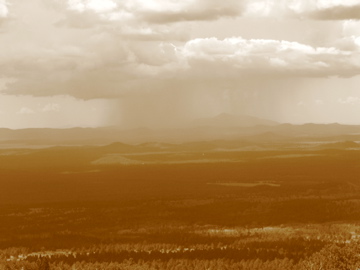Good Times Bad Times…
…is the opening track on Led Zeppelin’s self-titled debut album from 1969. The song was a difficult experiment in some respects – a lead guitar solo with a swirling effect, sixteenth-note triplets on a single kick drum, and busy riffs on a bass guitar. Riding on these sound waves, Robert Plant tells of a few instances from his youth that depict how he has had his share of times both good and bad.
As regional temperatures continue to rise, vegetation in the Southwest also seems to be having its share of good times and bad times. This is partly because temperature can influence plant growth in different ways.
When it is near or below freezing, air temperature can keep a plant dormant during the colder part of the year. Temperatures near or below freezing also can damage plant tissues if, for example, cold air settles in after vegetation has leafed out or begun to flower during the spring.
As the seasons shift towards summer and its warmer weather, air temperature can instead limit plant growth by raising the evapotranspirational demand of the atmosphere, or in other words, the atmospheric “need” for moisture. This potential of the atmosphere to wick away moisture from vegetation and induce physiological stress in leaves becomes increasingly greater as temperatures climb.
Warming over the past few decades in the Southwest has made for changes when it comes to when and where these limits act on plant growth – some good and some bad.

Temperatures too low for plant growth are not occurring as frequently at, for example, low-elevation areas of the region such as the Sonoran Desert in winter, or high-elevation forests in summer. As a result, plant growth has been less limited by low temperatures during these seasons for these places. Good, right?
It might be, but only to a certain extent.
That’s because with a warming climate, less time spent being limited by low temperatures can mean more time spent with relatively higher temperatures that drive greater atmospheric demand for evapotranspiration – that is, for moisture – and more limiting conditions for plant growth. And that, arguably, is bad.
In a study recently published in the Journal of Geophysical Research, we found these changes with limits on plant growth to have occurred during the 2000s drought, when compared to a previous drought that occurred during cooler times. Particularly remarkable were the changes that higher temperatures made to the atmospheric demand for evapotranspiration. At a large number of sites where tree mortality occurred during the 2000s drought, they helped evapotranspirational demand reach extreme levels from spring through autumn.
With anticipated further warming in the region, limiting conditions for plant growth that stem from evapotranspirational demand could intensify and spread from the warmer months of the year to earlier and later parts of the growing season, as well as to higher elevations. Another concern is that even more extreme evapotranspirational demand could occur during future droughts, exacerbating impacts of drier-than-normal conditions on regional vegetation.
If not the opening track, the 2000s drought is – at the very least – on the debut collection of how warming temperatures can affect regional vegetation. Drought and warmer temperatures in the Southwest could be a difficult experiment in some respects, as well.

